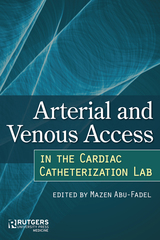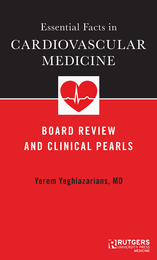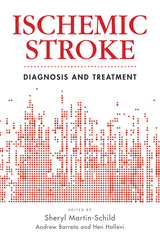3 books about Vascular

Arterial and Venous Access in the Cardiac Catheterization Lab
Arterial and Venous Access in the Cardiac Catheterization Lab
Abu-Fadel, Mazen
Rutgers University Press, 2016
Percutaneous cardiac and endovascular procedures are performed by a variety of interventional physicians and continue to evolve and expand. One of the most important steps in performing these procedures is vascular access and their Achilles heel is vascular access site complications. This volume is intended to help the clinician by providing a practical overview of the techniques and technologies used in top catheterization laboratories to access the arterial and venous beds.
Dr. Mazen Abu-Fadel and his contributors, part of the renowned cardiovascular team at the University of Oklahoma Health Sciences Center, carefully walk the reader through the various techniques used to obtain vascular access into most arterial and venous sites. They thoroughly describe current data, techniques, advantages, risks, and benefits of each vascular access site. Covering everything from anatomic landmarks to closures devices, Arterial and Venous Access in the Cardiac Catheterization Lab offers a complete overview of each procedure. In addition, it provides an up-to-date guide to the best medical technologies and equipment used when performing these procedures.
Arterial and Venous Access in the Cardiac Catheterization Lab is an invaluable resource for a wide range of clinical personnel, from attending physicians and trainees to nursing staff and vascular technicians. Written by experienced leaders in the field, it demonstrates how to perform complex, risky procedures while providing patients with expert care.
[more]

Essential Facts in Cardiovascular Medicine
Board Review and Clinical Pearls
Yeghiazarians, Yerem
Rutgers University Press, 2018
The treatment and management of cardiovascular disease has seen rapid advances in recent years; as a trainee or practitioner of cardiovascular medicine, it can be difficult to find the time to stay abreast of recent updates in information. Unlike standard exhaustive text and reference titles, Essential Facts in Cardiovascular Medicine provides the most critical facts and clinical pearls of cardiovascular medicine, in a high-yield, concise, bulleted format that can fit in your pocket. Essential Facts in Cardiovascular Medicine is the perfect guide to enhance your cardiovascular knowledge, prepare for board examinations, and improve clinical practice.
Essential Facts in Cardiovascular Medicine covers numerous important topics from the basics of Statistics, to factoids in General Cardiology, Physical Exam, EKG, Congenital Heart Disease, Valvular Heart Disease, Heart Failure/Transplant, Acute Coronary Syndromes, Pericardial Diseases, Electrophysiology, Pharmacology, Pregnancy, Pulmonary Hypertension, Peripheral Vascular Disease, Echocardiography, Formulas, Interventional Cardiology and Cardiac Tumors.
Essential Facts in Cardiovascular Medicine covers numerous important topics from the basics of Statistics, to factoids in General Cardiology, Physical Exam, EKG, Congenital Heart Disease, Valvular Heart Disease, Heart Failure/Transplant, Acute Coronary Syndromes, Pericardial Diseases, Electrophysiology, Pharmacology, Pregnancy, Pulmonary Hypertension, Peripheral Vascular Disease, Echocardiography, Formulas, Interventional Cardiology and Cardiac Tumors.
[more]

Ischemic Stroke
Diagnosis and Treatment
Martin-Schild, Sheryl
Rutgers University Press, 2018
Stroke is the fifth leading cause of death in the United States and is a leading cause of adult disability and discharge from hospitals to chronic care facilities. Despite the frequency and morbidity of stroke, there is a relative paucity of “stroke experts,” such as vascular neurologists and neurocritical care physicians, to care for these patients. Clinical research in the diagnosis and treatment of stroke has grown exponentially over the past two decades resulting in a great deal of new clinical information for attending physicians to absorb. Grounded in cutting-edge and evidence-based strategies, Ischemic Stroke closes the gap in stroke care by providing a cogent and intuitive guide for all physicians caring for stroke patients.
Key topics explored cover all elements of stroke care, including examinations of: emergent evaluation of the suspected stroke patient, clinical signs and symptoms of stroke, mechanisms of ischemic stroke, neuroimaging, cardiac-based evaluation, thrombolytic therapy, endovascular therapy, critical care management, rehabilitation, cardiac arrhythmias, and structural heart disease.
Key topics explored cover all elements of stroke care, including examinations of: emergent evaluation of the suspected stroke patient, clinical signs and symptoms of stroke, mechanisms of ischemic stroke, neuroimaging, cardiac-based evaluation, thrombolytic therapy, endovascular therapy, critical care management, rehabilitation, cardiac arrhythmias, and structural heart disease.
[more]
READERS
Browse our collection.
PUBLISHERS
See BiblioVault's publisher services.
STUDENT SERVICES
Files for college accessibility offices.
UChicago Accessibility Resources
home | accessibility | search | about | contact us
BiblioVault ® 2001 - 2024
The University of Chicago Press









